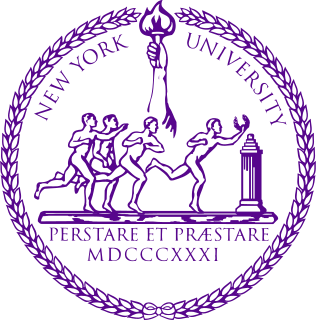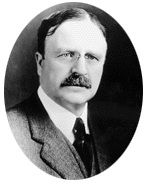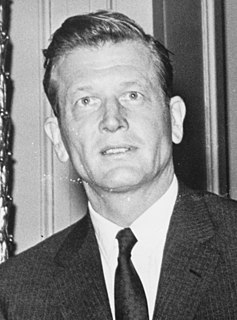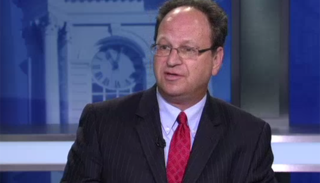James A. Burke | |
|---|---|
| Borough President of Queens | |
| In office 1942–1949 | |
| Preceded by | George U. Harvey |
| Succeeded by | Maurice A. FitzGerald |
| Personal details | |
| Born | March 3, 1890 Brooklyn, New York, U.S. |
| Died | September 12, 1965 (aged 75) Little Neck, New York, U.S. |
James A. Burke (March 3, 1890 – September 12, 1965) was a Democratic politician from Queens, New York City and served as its borough president for eight years.

The Democratic Party is one of the two major contemporary political parties in the United States, along with the Republican Party. Tracing its heritage back to Thomas Jefferson and James Madison's Democratic-Republican Party, the modern-day Democratic Party was founded around 1828 by supporters of Andrew Jackson, making it the world's oldest active political party.

Queens is the easternmost of the five boroughs of New York City. It is the largest borough geographically and is adjacent to the borough of Brooklyn at the southwestern end of Long Island. To its east is Nassau County. Queens also shares water borders with the boroughs of Manhattan and the Bronx. Coterminous with Queens County since 1899, the borough of Queens is the second largest in population, with an estimated 2,358,582 residents in 2017, approximately 48% of them foreign-born. Queens County also is the second most populous county in the U.S. state of New York, behind Brooklyn, which is coterminous with Kings County.

The City of New York, usually called either New York City (NYC) or simply New York (NY), is the most populous city in the United States. With an estimated 2017 population of 8,622,698 distributed over a land area of about 302.6 square miles (784 km2), New York is also the most densely populated major city in the United States. Located at the southern tip of the state of New York, the city is the center of the New York metropolitan area, the largest metropolitan area in the world by urban landmass and one of the world's most populous megacities, with an estimated 20,320,876 people in its 2017 Metropolitan Statistical Area and 23,876,155 residents in its Combined Statistical Area. A global power city, New York City has been described as the cultural, financial, and media capital of the world, and exerts a significant impact upon commerce, entertainment, research, technology, education, politics, tourism, art, fashion, and sports. The city's fast pace has inspired the term New York minute. Home to the headquarters of the United Nations, New York is an important center for international diplomacy.
Burke was born in Brooklyn, New York in 1890 [1] but was orphaned when he was 8 years old. [2] After high school he took night classes at New York University while he worked. In 1914 he moved to Queens, where he became active in many civic organizations. [1] During the first World War he worked as a civilian at the Brooklyn Navy Yard, eventually becoming superintendent of stock in charge of $60 million worth of supplies. [1] [2]

New York University (NYU) is a private research university originally founded in New York City but now with campuses and locations throughout the world. Founded in 1831, NYU's historical campus is in Greenwich Village, New York City. As a global university, students can graduate from its degree-granting campuses in NYU Abu Dhabi and NYU Shanghai, as well as study at its 12 academic centers in Accra, Berlin, Buenos Aires, Florence, London, Los Angeles, Madrid, Paris, Prague, Sydney, Tel Aviv, and Washington, D.C.

The Brooklyn Navy Yard is a shipyard and industrial complex located in northwest Brooklyn in New York City, New York. The Navy Yard is located on the East River in Wallabout Bay, a semicircular bend of the river across from Corlears Hook in Manhattan. It is bounded by Navy Street to the west, Flushing Avenue to the south, Kent Avenue to the east, and the East River on the north. The site, which covers 225.15 acres (91.11 ha), is listed on the National Register of Historic Places.
After the war, he had various jobs in purchasing and accounting. He had leadership positions in two Queens civic organizations. He was a member of the New York State Assembly (Queens Co., 4th D.) in 1931, 1932, 1933 and 1935. While there, he championed Queens issues, including the construction of the Grand Central Parkway. [2]

The New York State Assembly is the lower house of the New York State Legislature, the New York State Senate being the upper house. There are 150 seats in the Assembly, with each of the 150 Assembly districts having an average population of 128,652. Assembly members serve two-year terms without term limits.

The 154th New York State Legislature, consisting of the New York State Senate and the New York State Assembly, met from January 7 to September 19, 1931, during the third year of Franklin D. Roosevelt's governorship, in Albany.

The 155th New York State Legislature, consisting of the New York State Senate and the New York State Assembly, met from January 6 to December 14, 1932, during the fourth year of Franklin D. Roosevelt's governorship, in Albany.
In 1941, he won election as borough president of Queens, beating the Republican incumbent George U. Harvey. While in office, he focused on transportation and taxes in the borough. [3] He won two terms to the office, and resigned in 1949. He did not seek any further political offices.
Borough president is an elective office in each of the five boroughs of New York City. For most of the city's history, the office exercised significant executive powers within each borough, and the five borough presidents also sat on the New York City Board of Estimate. Since 1990, the borough presidents have been stripped of a majority of their powers in the government of New York City.
George U. Harvey was a Republican politician from Queens, New York City and served as its borough president for twelve years.
He died in his Little Neck, Queens, home in 1965.









